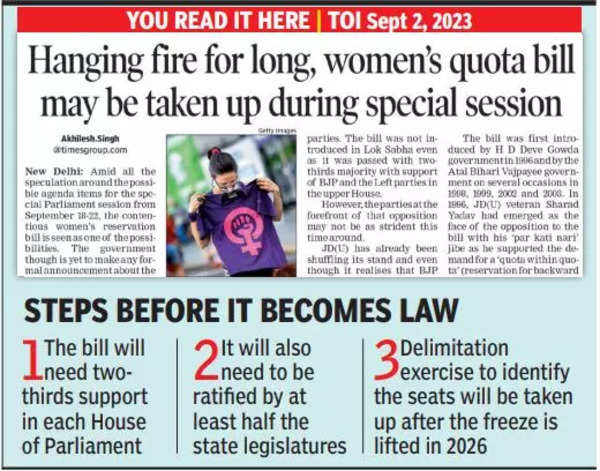[ad_1]
The decision, pushed by the Prime Minister and cleared by the Union Cabinet at a meeting on Monday evening, aims to secure passage of the bill in the two Houses in the special session, beginning a long process that will entail support, besides two-thirds backing in both Houses and ratification by half of the assemblies.The bill will also provide for sub-quota for SC/STs in proportion to their existing share.
The government refused to confirm the decision, but sources said that the proposed reservation could come into force by 2029 after the constituencies are redrawn as part of the delimitation exercise based on the decennial census expected to get under way in 2026.The bill was first introduced in 1996, and even cleared by the Rajya Sabha in March 2010, but lapsed after the Lok Sabha failed to pass it.
Sources in the government were confident of the prospects of the bill in Parliament this time, as well as of enlisting the necessary support from states. They said Congress would have to come along and pointed to states which are with BJP, its allies as well as parties which though not part of the NDA have been in support of the measure.

The PM himself did not appear to be in doubt as he declared that the special session would be “historic”. In his “farewell speech” in the old Parliament, he had dropped a clear hint about what was afoot when he talked about “inclusiveness” as one of the hallmarks of Indian parliamentary democracy and talked about contributions of women lawmakers, two Speakers included.
Congress announced its support for the bill as soon as information about the decision filtered out. The bill will be put up for discussion in the Lok Sabha on Wednesday, with the government hoping to secure its passage in the Rajya Sabha on Friday, the concluding day of the special session.
The decision marks fulfilment of the decades-old demand of women’s organisations and political parties for decisive affirmative action for enhancing their representation in legislatures. The intent of political parties could not be translated into quota because of the resistance of politicians who feared losing their seats to women once the quota was promulgated.
Many who claimed to represent OBCs and Muslims put a spanner in the works, arguing that “women’s quota” would be appropriated by upper caste women.

Govt confident of pushing through women’s quota law
After several decades of wait, the Congress-led UPA brought a Constitution amendment bill to the Rajya Sabha in December 2010 to reserve one-third of seats in legislatures for women. With BJP and Left supporting it fully, it had enough support in the Upper House. But with Samajwadi Party and RJD protesting angrily and demanding that a big chunk of women’s quota seats be assigned exclusively to those from the OBC and minority communities, the government had to defer passage of the bill.
The legislation was cleared by the Rajya Sabha in March 2010, but the resistance put up by SP and RJD, and the JD(U), then a member of the BJP-led NDA, and their allegation about women’s quota being an upper caste conspiracy to regain their political pre-eminence caused the Manmohan Singh government to have a rethink. The cold feet ensured that the bill lapsed after dissolution of the Lok Sabha in 2014.

The Modi government is confident of getting past the roadblocks this time. For one, BJP has a majority of its own and can easily reach the two-thirds threshold with the support of its allies, those belonging to nonaligned parties like BJD and YSRCP as well as opponents like Congress, BRS and others who will not like to junk their position favouring women’s quota even if they feel that BJP’s political calculations are the main driver of the move and its timing. Congress’s statements and social media posts of its functionaries, which came against the backdrop of gathering indications of BJP’s intent, focused on their claim of being the “first mover” rather than opposition to women’s quota as such.
Secondly, although the build-up to the move, which saw President Droupadi Murmu’s strong backing for women’s quota and RSS’s exhortation to Sangh-influenced organisations to work to end gender imbalance in all arenas, has seen SP and RJD reiterating their opposition to the idea, BJP has enough numbers to negotiate the challenge. In contrast, SP and RJD stand diminished. Even JD(U), which has appeared to mellow its position, has to reckon with the signs of emergence of women as an independent electoral category.
Parliament Special Session: “Better late than never…” Shatrughan Sinha on Women’s Reservation Bill
Above all, the initiative this time has come from the PM, who, sources said, is determined to make women’s quota a reality. “This is Modi’s guarantee,” said a senior member of the Cabinet amid indications that thanksgiving celebrations are being planned after Friday.
In fact, women’s reservation getting a decisive push has been talked about as a realistic prospect since Modi unveiled his plan for the new building of Parliament, a cavernous structure which can accommodate the accretion which will come in the wake of delimitation.
Special Parliament Session: New building, Bills, All-party Meet, What else will happen? All speculations explored
[ad_2]
Source link










More Stories
We can’t wait to face India in the final: Pat Cummins | Cricket News
Railways plans 3,000 additional trains in next 4-5 years to minimise number of waitlisted tickets | India News
Faridabad: Man dies after ‘falling from hotel room window’ while partying with friends